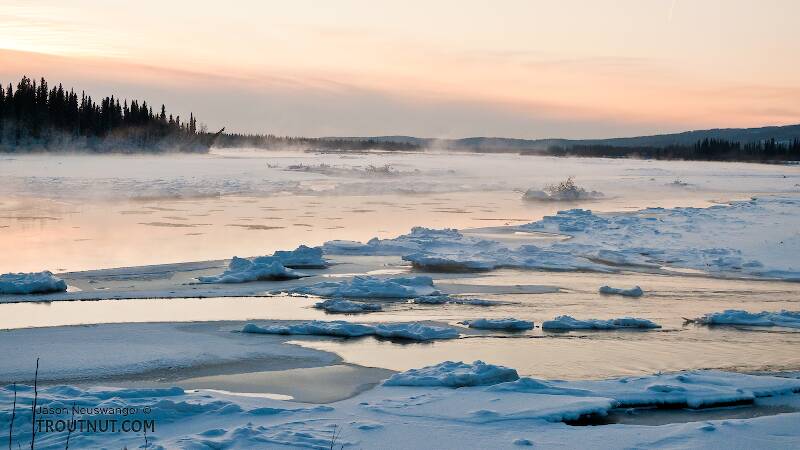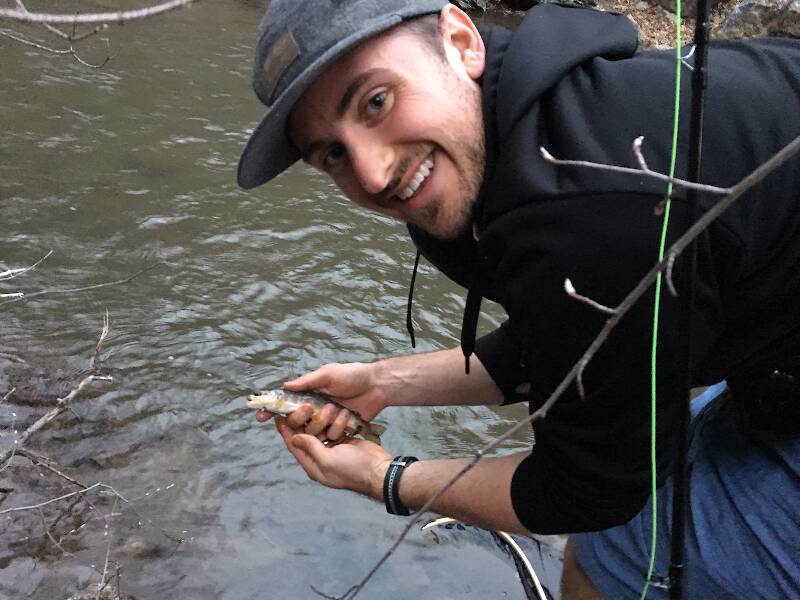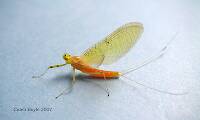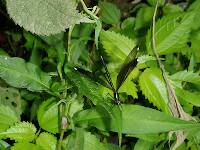
Hex Mayflies
Hexagenia limbata
The famous nocturnal Hex hatch of the Midwest (and a few other lucky locations) stirs to the surface mythically large brown trout that only touch streamers for the rest of the year.
Featured on the forum

This wild-looking little thing completely puzzled me. At first I was thinking beetle or month larva, until I got a look at the pictures on the computer screen. I made a couple of incorrect guesses before entomologist Greg Courtney pointed me in the right direction with Psychodidae. He suggested a possible genus of Thornburghiella, but could not rule out some other members of the tribe Pericomini.

Troutnut is a project started in 2003 by salmonid ecologist Jason "Troutnut" Neuswanger to help anglers and
fly tyers unabashedly embrace the entomological side of the sport. Learn more about Troutnut or
support the project for an enhanced experience here.
FlyCoug on May 3, 2016May 3rd, 2016, 8:43 am EDT
What should i know about fly selection and entomology as a beginner? I feel like I can easily get overwhelmed.
I think I know the difference between mayfly vs caddis vs midge, but i very quickly get confused when someone starts talking about different baedis flies.
I also think I have a grasp on nymph vs emerger vs dry fly.
By the way, I do my fishing on the Provo River, mainly the Lower Provo.
I think I know the difference between mayfly vs caddis vs midge, but i very quickly get confused when someone starts talking about different baedis flies.
I also think I have a grasp on nymph vs emerger vs dry fly.
By the way, I do my fishing on the Provo River, mainly the Lower Provo.
Taxon on May 3, 2016May 3rd, 2016, 11:52 am EDT
Hi Bryson-
Welcome aboard. Nice first post. Seems to me that you nave a pretty good understanding of aquatic insects for a beginner. You will learn more by asking questions when something is confusing to you.
Welcome aboard. Nice first post. Seems to me that you nave a pretty good understanding of aquatic insects for a beginner. You will learn more by asking questions when something is confusing to you.
TimCat on May 3, 2016May 3rd, 2016, 4:11 pm EDT
FlyCoug,
This site is a good start. I am also new to this and I have been going over the aquatic insect encyclopedia section on this site for a few months now. The creator and contributors have thrown some wonderful pics and info up. There are good pictures, descriptions and discussions based on the the different genus and species.
Also, try googling 'hatch charts' for your region to get a good idea on what you may want to look for out on the water, or for what you may want to have in your box next time you go out. They are usually in order by date for when that species or genus is commonly hatching. This helps with sorting through the overwhelming amount of info out there, because you can focus on what you may need to know for your current plans, one species at a time. At least it has helped my understanding... I am still very much a novice.
Also, go to a local fly shop, ask questions, and buy some flies! I've found that most shops are happy to get you going in the right direction... especially with someone who is buying flies, gear, etc from them.
Good luck
This site is a good start. I am also new to this and I have been going over the aquatic insect encyclopedia section on this site for a few months now. The creator and contributors have thrown some wonderful pics and info up. There are good pictures, descriptions and discussions based on the the different genus and species.
Also, try googling 'hatch charts' for your region to get a good idea on what you may want to look for out on the water, or for what you may want to have in your box next time you go out. They are usually in order by date for when that species or genus is commonly hatching. This helps with sorting through the overwhelming amount of info out there, because you can focus on what you may need to know for your current plans, one species at a time. At least it has helped my understanding... I am still very much a novice.
Also, go to a local fly shop, ask questions, and buy some flies! I've found that most shops are happy to get you going in the right direction... especially with someone who is buying flies, gear, etc from them.
Good luck
"If I'm not going to catch anything, then I 'd rather not catch anything on flies" - Bob Lawless
Jmd123 on May 3, 2016May 3rd, 2016, 5:11 pm EDT
Welcome Bryson. Your first priority is to get the Orders down, the mayflies (Ephemeroptera), stoneflies (Plecoptera), and caddisflies (Trichoptera). As far as fly fishing goes, once you have those three groups down, it is mostly variations on a theme as far as imitation goes. As in size and colors. Baetids are members of a family (Baetidae), the next step in classification below order. Each order has numerous families, and this is where the variation in size and color (and lifestyles of the immature aquatic forms) comes in. As a fly fisherman you don't have to know family names in order to successfully imitate the flies, in fact some general imitations will often work for several families (unless you're a serious "hatch matcher" and insist on being exact in your imitations, which in fact sometimes the trout demand).
As far as learning how to match hatches, this site is a good resource, but so is your local fly shop. Any shop worth it's graphite keeps track of the local hatches and will be more than happy to fill you in, and perhaps empty your wallet a bit on their flies. We all start out this way, and eventually many of us tie our own to save $$$ and build our own custom patterns fit to our conditions.
There are also some good books out there on basic aquatic ecology, they will get you started with the basics of entomology (and remember, there's terrestrial insects to imitate too, but they are beetles, grasshoppers, and ants and everyone knows them), and if you have no trouble in comprehension of the material, you can move on to more technical books like Merritt & Cummins' Introduction to the Aquatic insects of North America, which is full of more entomology than you ever wanted to know (unless you're an aquatic ecologist).
Check out the bug pages on this site and good luck in your fly fishing and entomological adventures!
Jonathon
As far as learning how to match hatches, this site is a good resource, but so is your local fly shop. Any shop worth it's graphite keeps track of the local hatches and will be more than happy to fill you in, and perhaps empty your wallet a bit on their flies. We all start out this way, and eventually many of us tie our own to save $$$ and build our own custom patterns fit to our conditions.
There are also some good books out there on basic aquatic ecology, they will get you started with the basics of entomology (and remember, there's terrestrial insects to imitate too, but they are beetles, grasshoppers, and ants and everyone knows them), and if you have no trouble in comprehension of the material, you can move on to more technical books like Merritt & Cummins' Introduction to the Aquatic insects of North America, which is full of more entomology than you ever wanted to know (unless you're an aquatic ecologist).
Check out the bug pages on this site and good luck in your fly fishing and entomological adventures!
Jonathon
No matter how big the one you just caught is, there's always a bigger one out there somewhere...
Quick Reply
Related Discussions
Topic
Replies
Last Reply








